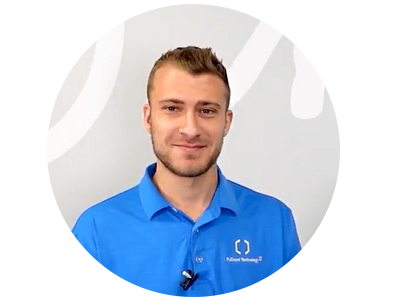Industrial automation is a balancing act engineers know all too well. Constantly trying to add flexibility to your operations without losing the solid reliability you love about traditional automation can quickly become frustrating and costly. Enter the PLCnext by Phoenix Contact. Far from being just another programmable logic controller (PLC), this solution merges the tried-and-true PLC design with the dynamic power of a Linux operating system. Here, we are answering the commonly asked questions that are heard across this community, making sure you understand all the ways PLCnext can easily fit into your operations. Let's get started.
Is the video not loading? Watch here
Jump to a Section
What is PLCnext, and how does it differ from Traditional PLCs? | How do you use PLCnext? | Are There Any Success Stories or Case Studies of PLCnext in Action? | What Kind of Support and Community Resources Are Available for PLCnext Users? | Resources
Download PLCnext Flyer | Shop PLCnext Today!
Key Takeaways✔️ PLCnext by Phoenix Contact merges traditional PLC reliability with modern flexibility through Linux integration, supporting multi-language development and enhancing cloud and IoT connectivity. ✔️ PLCnext, enhanced by user-friendly PLCnext Engineer software, Ignition SCADA integration, and versatile hardware options, offers a powerful and adaptable data management and control solution for automation engineers. ✔️ Joining the PLCnext community offers a collaborative learning environment with resources like forums, documentation, tutorials, and online learning, fostering continuous growth in industrial automation efficiency, precision, and creativity. |
1. What Is PLCnext, And How Does It Differ from Traditional PLCs?
 PLCnext offers a unique blend of industrial technology, combining the reliability of traditional systems with the flexibility of modern solutions. Thanks mainly to its integration with the Linux operating system, combining open-source flexibility with precise, real-time processing. Unlike traditional PLCs, this solution offers more opportunities for software integration and upgrades yet remains compatible with the familiar IEC 61131 programming standards. Users can tap into different open-source resources, enabling customization and innovation that were previously unimaginable with closed, legacy systems.
PLCnext offers a unique blend of industrial technology, combining the reliability of traditional systems with the flexibility of modern solutions. Thanks mainly to its integration with the Linux operating system, combining open-source flexibility with precise, real-time processing. Unlike traditional PLCs, this solution offers more opportunities for software integration and upgrades yet remains compatible with the familiar IEC 61131 programming standards. Users can tap into different open-source resources, enabling customization and innovation that were previously unimaginable with closed, legacy systems.
Some of the key differences are listed below:
Enhanced Development: Unlike traditional PLCs, PLCnext Technology allows multiple developers to work independently on a single controller program using different programming languages. This feature speeds up the development of complex applications by combining the advantages of the classic PLC world with the flexibility of PLCnext Technology.
Enhanced Performance: PLCnext Technology surpasses traditional PLCs by combining program sequences in different languages to create desired tasks. This patented technology ensures consistent data exchange and synchronous execution of the program code, making your high-level language programs deterministic automatically.
Enhanced Freedom: Traditional PLCs often limit the combination of independently created program parts and complete applications. PLCnext Technology lifts this constraint, and the usage of open-source software and apps enhances the efficiency of your development process.
Enhanced Connectivity: Unlike traditional PLCs, PLCnext Technology allows the integration of current and future interfaces and protocols for open communication in highly networked automation systems. This feature enables the implementation of new IoT-based models through direct connections to cloud-based services and databases.
Enhanced Convenience: PLCnext Technology's openness allows you to use your favorite programming language, whether IEC 61131 or high-level languages. Unlike traditional PLCs, you can develop your unique solution comfortably in your preferred development environment, such as PLCnext Engineer (function block, ladder, structured text), MATLAB/Simulink, C++, or Visual Studio.
2. How Do I Use PLCnext?
Mastering PLCnext is now easier than ever. At its core, you'll find PLCnext Engineer, a user-friendly software platform that makes software development smoother and adheres to IEC 61131 standards. For experts, PLCnext supports multiple programming languages such as C++, C#, and MATLAB/Simulink, opening up endless possibilities for custom solutions.
PLCnext stands out in automation. It integrates seamlessly with Ignition, a cutting-edge SCADA system that's transforming data collection. By using protocols like OPC UA and Sparkplug B via MQTT, PLCnext becomes a powerful tool for managing data.
The hardware, PLCnext Control, offers a range of configurations for IO and HMI, boosting control capabilities. The PLCnext ecosystem is enriched with resources like community forums and online learning modules, ensuring an easy learning process.
The system's adaptability extends to hardware. Using Phoenix Contact's Axioline I/O, you can choose from various smart components to comprehensive remote I/O systems. In short, PLCnext is a comprehensive solution catering to all levels of automation engineers.
📋 More information on the PLCnext Ecosystem
What Are PLCnext Real-World Applications?
![]() PLCnext works great as a regular Programmable Logic Controller (PLC), giving you the reliability and control you expect. But what sets it apart is its remarkable ability for data analytics and easy connection with various cloud platforms. This means PLCnext can not just process and analyze data right where it is but also work together with other systems to improve how things run and make smarter decisions.
PLCnext works great as a regular Programmable Logic Controller (PLC), giving you the reliability and control you expect. But what sets it apart is its remarkable ability for data analytics and easy connection with various cloud platforms. This means PLCnext can not just process and analyze data right where it is but also work together with other systems to improve how things run and make smarter decisions.
Whether acting as an intelligent bridge between different technologies or working as a sensor and an actuator in complex industrial environments, PLCnext's flexibility is impressive. Its openness to diverse industrial needs and its supportive environment for software development make PLCnext a key player in industrial innovation, pushing the limits of what automation and control systems can do.
What Kind of Support and Community Resources Are Available for PLCnext Users?
 Engaging with PLCnext technology opens the door to more than just cutting-edge solutions. It welcomes you into a nurturing community powered by Phoenix Contact, filled with informational wealth and mutual learning.
Engaging with PLCnext technology opens the door to more than just cutting-edge solutions. It welcomes you into a nurturing community powered by Phoenix Contact, filled with informational wealth and mutual learning.
 The PLCnext community, a thriving platform, features a wealth of resources for users, including interactive forums, thorough documentation, step-by-step tutorials, and online learning opportunities to enhance proficiency further. Phoenix Contact's commitment to supporting your progress doesn't stop at providing a robust framework for harnessing the power of PLCnext. It extends to fostering a community where knowledge transfer is seamless and encouraged.
The PLCnext community, a thriving platform, features a wealth of resources for users, including interactive forums, thorough documentation, step-by-step tutorials, and online learning opportunities to enhance proficiency further. Phoenix Contact's commitment to supporting your progress doesn't stop at providing a robust framework for harnessing the power of PLCnext. It extends to fostering a community where knowledge transfer is seamless and encouraged.
Through shared experiences and continuous learning, the PLCnext community is consistently expanding and evolving, shaping the future of industrial automation technology. The platform's advanced features, like trend analysis, alarm management, and cloud-based device management, make complex tasks simple and accessible to all, irrespective of their technological prowess.
With each update, data transaction, and new integration, the PLCnext community continues to grow and evolve and pave the way toward a future of efficiency, precision, and limitless creativity. Join the PLCnext community to make an impact in the automation world—it's your link to achieving your industrial aspirations.
Are you interested? Contact us to schedule a demo or answer your questions. Happy programming!








Leave Comment